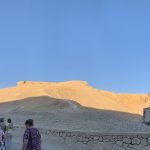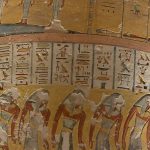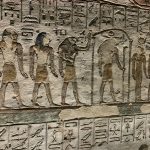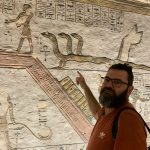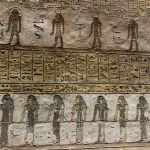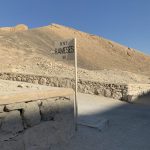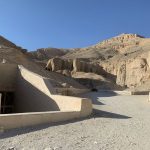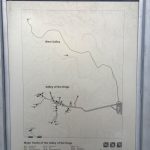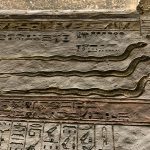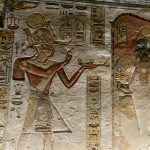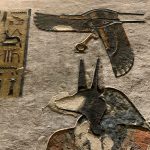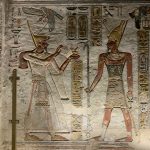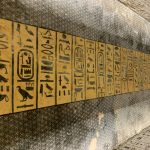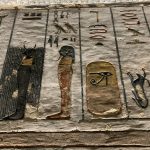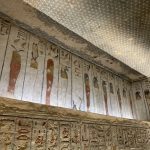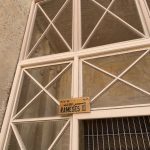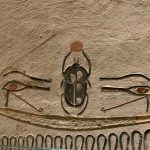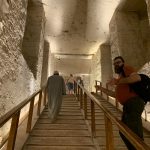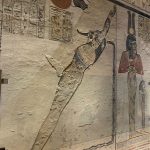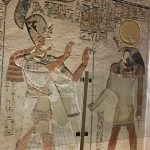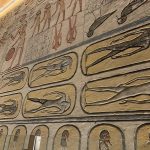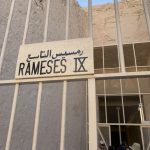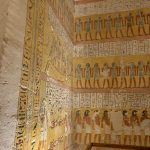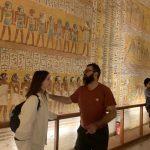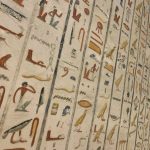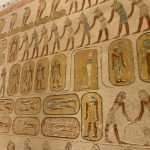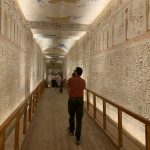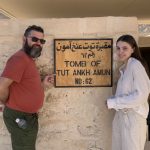We travelled by bus to the Valley of the Kings. A most memorable day. In modern times this valley has become famous for the discovery of the tomb of Tutankhamun. In 1979, it became a World Heritage Site, along with the rest of the Theban Necropolis. After 1500 B.C., the Egyptian kings no longer undertook great projects like building pyramids and so, the Valley of the Kings became the main designated burial location.
Located in 4,000 year-old Luxor, the Valley of the Kings contains highly decorated tombs, constructed to once house the regal sarcophagi-enclosed mummies of the mighty pharaohs awaiting their passage into the after-life.
We (my daughter Jenna and I) explored four tombs, Ramses II, Ramses IV, Ramses IX and finally Tutankamun! Howard Carter, the famous Egyptologist, discovered the tomb of King Tutankhamun in November 1922, financed by Lord Carnarvon.
Tutankhamen lived over 3,300 years ago during the New Kingdom period. For two centuries, Egypt had ruled as a world superpower, while its royal family lived an opulent lifestyle. The powerful priesthood of the god Amun had controlled vast temples and estates. Amenhotep IV (Akhenaten) -Tutankhamun’s father renounced the multitude of gods worshipped by the Egyptians, abolished the priesthood and established a new order to worship the sun god Aten and changed his own name to Akhenaten, meaning ‘servant of the Aten.’
Upon the death of Akhenaten, Tutankhaten (Tutankhamun) became king at the age of 9yrs. He ruled for a very short time and died in 1325 BC of somewhat mysterious causes. After 70 days, King Tut’s mortuary tomb was sealed and remained almost untouched until Howard Carter’s astonishing find. King Tutankhamen’s solid gold funerary mask and his priceless cache of treasures entombed with him for his journey to the afterlife, are now on display at the world famous Egyptian Museum in Cairo.
There are 63 tombs in the area, built there between 1539 BC to around 1075 BC. Often Valley of the Kings is abbreviated to KV. You can find more about the tombs at the Valley of the Kings – https://en.wikipedia.org/wiki/List_of_burials_in_the_Valley_of_the_Kings
There are at least 75 tombs in Biban al-Harim, the Valley of the Queens, around 4 of which are open. Deir al- Bahri, otherwise known as the famous Temple of Queen Hatshepsut, rises out of the desert plain in a series of terraces. Partly rock-cut, partly freestanding, it is one of Egypt’s finest and most photographed monuments.
References:
http://www.mummies2pyramids.info/
http://www.egypt.travel/en/regions/nile-valley/luxor
https://www.ancient-egypt-online.com/valley-of-the-kings.html
https://www.nationalgeographic.com/archaeology-and-history/archaeology/valley-of-the-kings/
http://www.Thebanmappingproject.com



